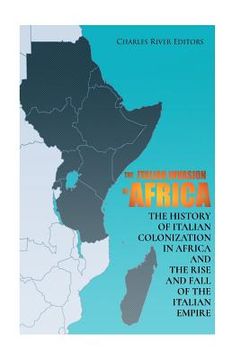The Italian Invasion of Africa: The History of Italian Colonization in Africa and the Rise and Fall of the Italian Empire (en Inglés)
Reseña del libro "The Italian Invasion of Africa: The History of Italian Colonization in Africa and the Rise and Fall of the Italian Empire (en Inglés)"
*Includes pictures *Includes online resources and a bibliography for further reading The modern history of Africa was, until very recently, written on behalf of the indigenous races by the white man, who had forcefully entered the continent during a particularly hubristic and dynamic phase of European history. In 1884, Prince Otto von Bismarck, the German chancellor, brought the plenipotentiaries of all major powers of Europe together, to deal with Africa's colonization in such a manner as to avoid provocation of war. This event-known as the Berlin Conference of 1884-1885-galvanized a phenomenon that came to be known as the Scramble for Africa. The conference established two fundamental rules for European seizure of Africa. The first of these was that no recognition of annexation would granted without evidence of a practical occupation, and the second, that a practical occupation would be deemed unlawful without a formal appeal for protection made on behalf of a territory by its leader, a plea that must be committed to paper in the form of a legal treaty. This began a rush, spearheaded mainly by European commercial interests in the form of Chartered Companies, to penetrate the African interior and woo its leadership with guns, trinkets and alcohol, and having thus obtained their marks or seals upon spurious treaties, begin establishing boundaries of future European African colonies. The ease with which this was achieved was due to the fact that, at that point, traditional African leadership was disunited, and the people had just staggered back from centuries of concussion inflicted by the slave trade. Thus, to usurp authority, to intimidate an already broken society, and to play one leader against the other was a diplomatic task so childishly simple, the matter was wrapped up, for the most part, in less than a decade. It is debatable whether Italian engagement in Africa pertained to this era of colonization or to a later era better associated with the rise of fascism, for the only African territory that the Italians acquired during the era of European imperialism was Eritrea, and it was only nominally held. It was only later, under Benito Mussolini, that Italian possession expanded in the Horn of Africa to include Ethiopia and Somalia. The Italian conquest of coastal Libya took place in 1911, and it was also established as a unified colony under Mussolini in 1934. Only two territories in Africa were not colonized in the formal sense of the word, and these were Ethiopia (which was occupied briefly by the Italians during World War II) and Liberia. The former, Ethiopia, existed during this period, as it had for centuries, as an imperial monarchy, and although various European powers held strong diplomatic interests in the country, it never became subject to formal annexation. Liberia, on the other hand, was a curiosity. It comprises a stretch of the West African coast that was known historically as the Pepper Coast, or the Grain Coast, as others were known as the Slave and Gold Coasts. It experienced periods of visitation by both the Portuguese and the British, but its permanent settlement by outsiders came about under very unusual circumstances. However, it cannot be underestimated how important Italian participation in the "Great Game" was, given what would transpire in the early 1940s. When World War II broke out, Italy's alignment with Nazi Germany meant that Italian possessions in Africa would turn the region into a crucial theater at the start of the war, and ultimately, the Italians' inability to stave off the Allies in Africa would lead to further German involvement there, at a time when Hitler could least afford to draw resources away from the fight against the Soviets. All of it would culminate in one of the most famous battles of the war at El Alamein, pitting the legendary Desert Fox, Erwin Rommel, against the British.

